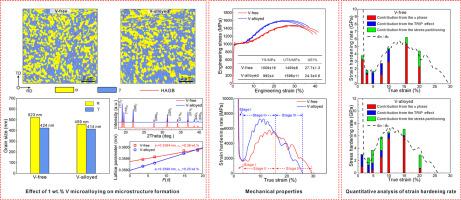IF 9.4
1区 材料科学
Q1 ENGINEERING, MECHANICAL
引用次数: 0
摘要
微合金化是一种完善的方法来调整常规钢的力学性能,但其对中锰钢的力学性能和潜在的变形机制的影响尚不清楚。在这里,我们报告了在有和没有0.1 wt.% V微合金化的情况下,对临界间退火的中Mn钢的变形行为进行了彻底的研究。与无v合金钢相比,v合金钢具有相当的屈服强度和均匀伸长率,但具有更高的极限抗拉强度和增强的应变硬化。分析表明,V微合金化优先与C原子反应形成VC相,VC相主要通过降低初始铁素体相中的C含量而不是阻碍相界面迁移来影响随后的铁素体向奥氏体转变。我们发现,相似的屈服强度源于铁素体的强度增加,这是由于细化的晶粒尺寸被减少的C含量引起的奥氏体强度下降所抵消。此外,我们首次定量地解决了v合金和无v钢中应变硬化的起源,其中变形诱发塑性(TRIP)效应、应力分配和位错活动在两种钢中起着根本不同的作用。在此基础上,我们发现v合金钢中的额外应变硬化归因于快速的TRIP效应、应力分配增强以及主要由统计存储的位错促进的活跃位错积累。目前的研究结果为微合金化在调节中Mn钢的变形行为和应变硬化中所起的作用提供了机制上的见解。本文章由计算机程序翻译,如有差异,请以英文原文为准。


Effect of vanadium microalloying on the deformation behavior and strain hardening of a medium Mn steel
Microalloying is a well-established approach for tailoring the mechanical properties of conventional steels, yet its effects on the mechanical properties and the underlying deformation mechanism for medium Mn steels remain elusive. Here, we report a thorough investigation of deformation behavior in the intercritically annealed medium Mn steels, both with and without the 0.1 wt.% V microalloying. The V-alloyed steel exhibits comparable yield strength and uniform elongation, but higher ultimate tensile strength and enhanced strain hardening, as compared to the V-free counterpart. Our analysis indicates that the V microalloying preferentially reacts with C atoms to form VC precipitates, which affect the subsequent ferrite to austenite transformation mainly by reducing the C content in the initial ferrite phase rather than impeding the phase interface migration. We reveal that the similar yield strengths originate from the increased strength of ferrite due to refined grain size being offset by the decreased strength of austenite arising from the reduced C content. Furthermore, for the first time, we quantitatively resolve the origins of strain hardening in the V-alloyed and V-free steels, where the transformation-induced plasticity (TRIP) effect, stress partitioning, and dislocation activities make fundamentally different contributions in the two steels. On this basis, we uncover that the extra strain hardening in the V-alloyed steel is ascribed to the rapid TRIP effect, enhanced stress partitioning, and active dislocation accumulation mainly facilitated by statistically stored dislocations. The present findings provide mechanistic insights into the role played by microalloying in modulating the deformation behavior and strain hardening of medium Mn steels.
求助全文
通过发布文献求助,成功后即可免费获取论文全文。
去求助
来源期刊

International Journal of Plasticity
工程技术-材料科学:综合
CiteScore
15.30
自引率
26.50%
发文量
256
审稿时长
46 days
期刊介绍:
International Journal of Plasticity aims to present original research encompassing all facets of plastic deformation, damage, and fracture behavior in both isotropic and anisotropic solids. This includes exploring the thermodynamics of plasticity and fracture, continuum theory, and macroscopic as well as microscopic phenomena.
Topics of interest span the plastic behavior of single crystals and polycrystalline metals, ceramics, rocks, soils, composites, nanocrystalline and microelectronics materials, shape memory alloys, ferroelectric ceramics, thin films, and polymers. Additionally, the journal covers plasticity aspects of failure and fracture mechanics. Contributions involving significant experimental, numerical, or theoretical advancements that enhance the understanding of the plastic behavior of solids are particularly valued. Papers addressing the modeling of finite nonlinear elastic deformation, bearing similarities to the modeling of plastic deformation, are also welcomed.
 求助内容:
求助内容: 应助结果提醒方式:
应助结果提醒方式:


